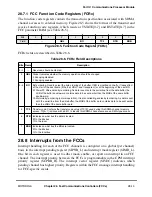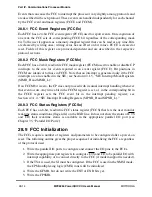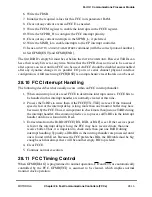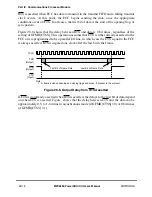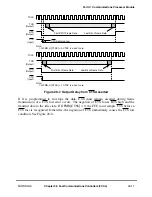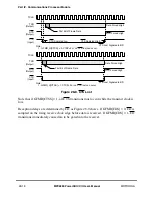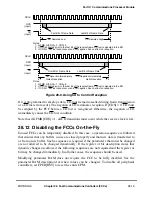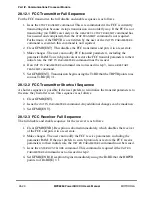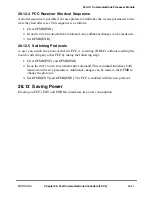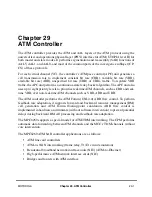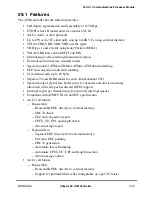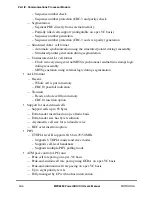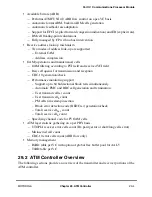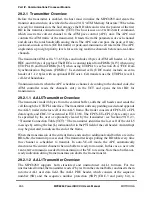
29-5
MPC8260 PowerQUICC II UserÕs Manual
MOTOROLA
Part IV. Communications Processor Module
29.2.1 Transmitter Overview
Before the transmitter is enabled, the host must initialize the MPC8260 and create the
transmit data structure, described in Section 29.10, ÒATM Memory Structure.Ó When data
is ready for transmission, the host arranges the BD table and writes the pointer of the Þrst
BD in the transmit connection table (TCT). The host issues an
ATM
TRANSMIT
command,
which inserts the current channel to the ATM pace control (APC) unit. The APC unit
controls the ATM trafÞc of the transmitter. It reads the trafÞc parameters of each channel
and divides the total bandwidth among them. The APC unit can pace the peak cell rate,
peak-and-sustain cell rate (GCRA trafÞc) or peak-and-minimum cell rate trafÞc. The APC
implements up to eight priority levels for servicing real-time channels before non-real-time
channels.
The transmitter ATM cell is 53Ð65 bytes and includes 4 bytes of ATM cell header, a 1-byte
HEC, and 48 bytes of payload. The HEC is a constant taken from FDSR
x
[0Ð15] when using
UTOPIA 16 and from FDSR
x
[8Ð15] when using UTOPIA 8; see Section 28.4, ÒFCC Data
Synchronization Registers (FDSRx).Ó User-deÞned cells (UDC mode) include an extra
header of 1Ð12 bytes with an optional HEC octet. Cell transfers use the UTOPIA level II,
cell-level handshake.
Transmission starts when the APC schedules a channel. According to the channel code, the
ATM controller reads the channelÕs entry in the TCT and opens the Þrst BD for
transmission.
29.2.1.1 AAL5 Transmitter Overview
The transmitter reads 48 bytes from the external buffer, adds the cell header, and sends the
cell through the UTOPIA interface. The transmitter adds any padding needed and appends
the AAL5 trailer in the last cell of the AAL5 frame. The trailer consists of CPCS-UU+CPI,
data length, and CRC-32 as deÞned in ITU I.363. The CPCS-UU+CPI (2-byte entry) can
be speciÞed by the user or optionally cleared by the transmitter; see Section 29.10.2.3,
ÒTransmit Connection Table (TCT).Ó The transmitter identiÞes the last cell of the AAL5
message by setting the last (L) indication bit in the PTI Þeld of the cell header. An interrupt
may be generated to indicate the end of the frame.
When the transmission of the current frame ends and no additional valid buffers are in the
BD table, the transmit process ends. The transmitter keeps polling the BD table every time
this channel is scheduled to transmit. In auto-VC-off mode, the APC automatically
deactivates the current channel when no buffer is ready to transmit. In this case, a new
ATM
TRANSMIT
command is needed for transmission of the VC to resume. Note that a buffer-not-
ready indication during frame transmission aborts the frame transfer.
29.2.1.2 AAL1 Transmitter Overview
The MPC8260 supports both structured and unstructured AAL1 formats. For the
unstructured format, the transmitter reads 47 bytes from the external buffer and inserts them
into the AAL1 user data Þeld. The AAL1 PDU header, which consists of the sequence
number (SN) and the sequence number protection (SNP) (CRC-3 and parity bit), is
Содержание MPC8260 PowerQUICC II
Страница 1: ...MPC8260UM D 4 1999 Rev 0 MPC8260 PowerQUICC II UserÕs Manual ª ª ...
Страница 32: ...xxxii MPC8260 PowerQUICC II UserÕs Manual MOTOROLA CONTENTS Paragraph Number Title Page Number ...
Страница 66: ...lxvi MPC8260 PowerQUICC II UserÕs Manual MOTOROLA ...
Страница 88: ...1 18 MPC8260 PowerQUICC II UserÕs Manual MOTOROLA Part I Overview ...
Страница 120: ...2 32 MPC8260 PowerQUICC II UserÕs Manual MOTOROLA Part I Overview ...
Страница 138: ...Part II iv MPC8260 PowerQUICC II UserÕs Manual MOTOROLA Part II Configuration and Reset ...
Страница 184: ...4 46 MPC8260 PowerQUICC II UserÕs Manual MOTOROLA Part II ConÞguration and Reset ...
Страница 202: ...Part III vi MPC8260 PowerQUICC II UserÕs Manual MOTOROLA Part III The Hardware Interface ...
Страница 266: ...8 34 MPC8260 PowerQUICC II UserÕs Manual MOTOROLA Part III The Hardware Interface ...
Страница 382: ...10 106 MPC8260 PowerQUICC II UserÕs Manual MOTOROLA Part III The Hardware Interface ...
Страница 392: ...11 10 MPC8260 PowerQUICC II UserÕs Manual MOTOROLA Part III The Hardware Interface ...
Страница 430: ...Part IV viii MOTOROLA Part IV Communications Processor Module ...
Страница 490: ...14 36 MPC8260 PowerQUICC II UserÕs Manual MOTOROLA Part IV Communications Processor Module ...
Страница 524: ...17 10 MPC8260 PowerQUICC II UserÕs Manual MOTOROLA Part IV Communications Processor Module ...
Страница 556: ...18 32 MPC8260 PowerQUICC II UserÕs Manual MOTOROLA Part IV Communications Processor Module ...
Страница 584: ...19 28 MPC8260 PowerQUICC II UserÕs Manual MOTOROLA Part IV Communications Processor Module ...
Страница 632: ...21 24 MPC8260 PowerQUICC II UserÕs Manual MOTOROLA Part IV Communications Processor Module ...
Страница 652: ...22 20 MPC8260 PowerQUICC II UserÕs Manual MOTOROLA Part IV Communications Processor Module ...
Страница 668: ...23 16 MPC8260 PowerQUICC II UserÕs Manual MOTOROLA Part IV Communications Processor Module ...
Страница 758: ...27 28 MPC8260 PowerQUICC II UserÕs Manual MOTOROLA Part IV Communications Processor Module ...
Страница 780: ...28 22 MPC8260 PowerQUICC II UserÕs Manual MOTOROLA Part IV Communications Processor Module ...
Страница 874: ...29 94 MPC8260 PowerQUICC II UserÕs Manual MOTOROLA Part IV Communications Processor Module ...
Страница 920: ...31 18 MPC8260 PowerQUICC II UserÕs Manual MOTOROLA Part IV Communications Processor Module ...
Страница 980: ...A 4 MPC8260 PowerQUICC II UserÕs Manual MOTOROLA Appendixes ...
Страница 1002: ...Index 22 MPC8260 PowerQUICC II UserÕs Manual MOTOROLA INDEX ...
Страница 1006: ......

